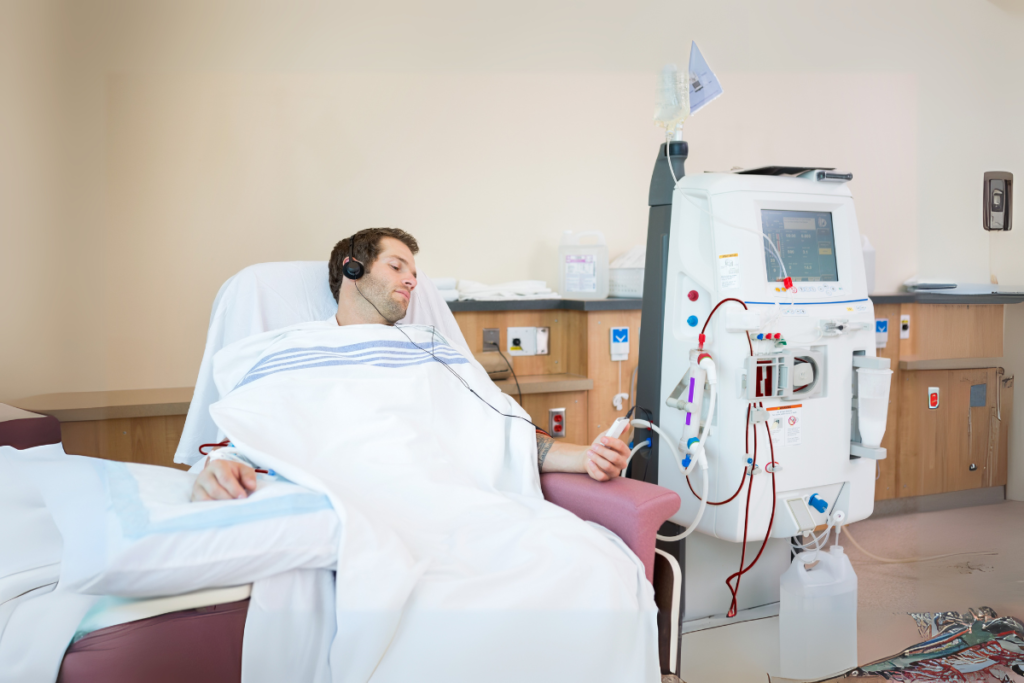Patients with end-stage renal disease (ESKD), in which the kidneys have no ability to eliminate waste and extra fluid from the body, can benefit greatly from dialysis. Dialysis performs the vital functions of the kidneys, such as removing waste products and maintaining fluid balance. In this article, we’ll explain what dialysis is, when it’s needed, and address common myths surrounding this essential treatment.
What is Dialysis?
Dialysis is a procedure used when the kidneys are no longer able to properly regulate the body’s fluid and electrolyte balance. There are two main types of dialysis:
● Hemodialysis: This type uses a machine to filter waste and excess fluid from the blood. Blood is drawn from the body, cleaned through a filter, and returned to the body.
● Peritoneal Dialysis: This uses the peritoneal membrane (lining of the abdomen) to filter waste and fluids from the blood. A sterile solution is introduced into the abdomen, where waste is absorbed before being drained out.
When is Dialysis Needed?
Dialysis is recommended when a patient’s kidney function declines to the point where it is no longer sufficient to filter out waste or regulate the body’s fluids. This usually occurs when the glomerular filtration rate (GFR) falls below 15 mL/min and the patient shows symptoms of kidney failure such as swelling, fatigue, and high blood pressure. Dialysis helps control these symptoms and is often required while waiting for a kidney transplant.
Busting Myths About Dialysis
1. Myth: Dialysis is painful.
● Reality: Dialysis is generally not painful. However, there may be some discomfort during the procedure, especially during needle insertion for hemodialysis or due to fluid shifts in peritoneal dialysis.
2. Myth: Dialysis is a cure for kidney disease.
● Reality: Dialysis is a life-saving treatment for kidney disease, but it is not a cure. It helps manage symptoms of kidney failure but does not restore kidney function.
3. Myth: Dialysis patients are bedridden and cannot lead an active life.
● Reality: While dialysis can be time-consuming, many patients can lead active lives with appropriate adjustments. Hemodialysis typically requires three sessions per week, while peritoneal dialysis can be done at home and is less restrictive.
4. Myth: Dialysis is only for elderly patients.
● Reality: Dialysis is used for patients of all ages who have end-stage kidney disease, regardless of their age. The decision to start dialysis depends on the severity of kidney failure and the patient’s overall health.
5. Myth: Dialysis is always temporary.
● Reality: Depending on the underlying cause of renal failure, dialysis can be either short-term or long-term. While some patients may need dialysis for the rest of their lives, others may eventually get a kidney transplant.
FAQs :
How often do I need dialysis?
Dialysis frequency is determined by the type of dialysis and the particular condition of the patient. Peritoneal dialysis can be performed at home every day, whereas hemodialysis is typically performed three times per week.
Can dialysis patients live a long life?
Yes, with proper care, many patients live for years on dialysis, though quality of life can improve with a kidney transplant.
Are there any side effects of dialysis?
Muscle cramps, exhaustion, and low blood pressure are common side effects, but these may usually be controlled with medication and modifications to the dialysis procedure.
Disclaimer:
This article is for educational purposes and should not replace professional medical advice. Always consult your healthcare provider for personalised medical recommendations.
How HealthPil Can Help:
At HealthPil, we connect you with nephrologists who specialise in dialysis treatment. Whether you’re considering dialysis or have been on dialysis for a while, our experts can guide you through the process, manage your treatment, and help you explore other options like kidney transplantation.

